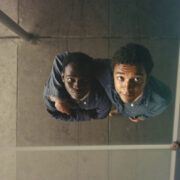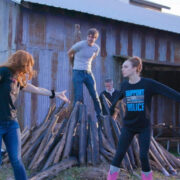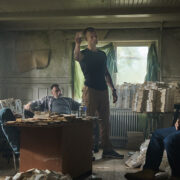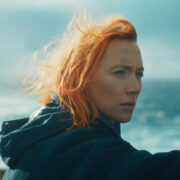A Musically-Gifted, Cosmically-Ambiguous & Cinematically-Shot Case For HAPPY FEET
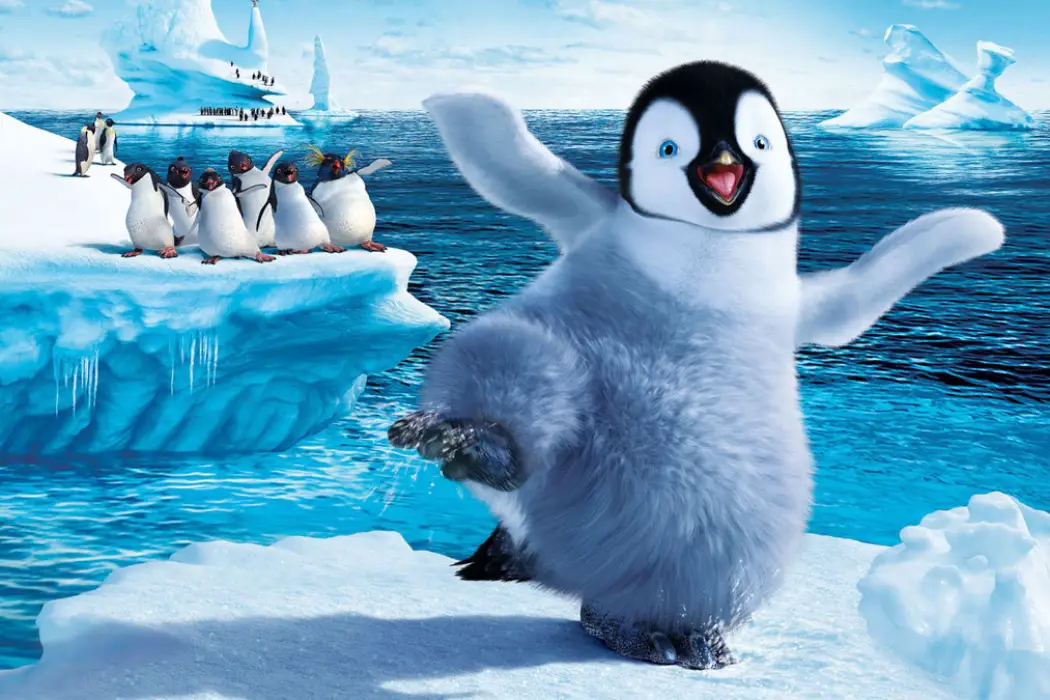
Currently working on his Bachelor's in Media Arts with a…
I saw Happy Feet in the Fall of 2006 when I was in the 3rd grade and to this day I fully believe it single-handedly changed my life forever. My parents even told me it was around that time that I wanted to see every single animated movie released in theaters after Happy Feet. And the thing about the mid-to-late 2000s that you might know is, there were a LOT of animated movies around then. They came out at a rate that seemed to rival only that of Netflix’s output of original movies/shows and still I somehow managed to force my parents to drag me to Every. Single. One.
So naturally it led me to think – what made Happy Feet the sole catalyst in the movie-watching frenzy that I exist in to this day? What was it about this movie in particular that led me to exhibit drug-addict level behavior with any and all animated movies for years? I may never really know the answer to all this, but I can say this: I don’t remember anything else in that same time period affecting me much the same way as George Miller’s animated opus did.
I think maybe it was because before Happy Feet (in my cinematic life there was Before Happy Feet, and there was After Happy Feet), I didn’t do much outside of playing Gameboy and building Legos. As far as I can remember, and from what I’ve surmised from my parents, I led a relatively movie-less childhood – or at least any movie that ever stuck with me for much longer than an hour.
One day, years later, when I happened to start watching Happy Feet in pursuit of nostalgic bliss, I was surprised to find out it wasn’t quite the perfect movie my 9 year-old’s self glowing praise touted it to be. One of the first things I noticed was just how much it borrows from older and better movies before it. It uses a lot of the same storytelling tropes and the same character archetypes and character arcs and you can pretty much tell where the movie is going after the first ten minutes if you’ve seen the “he was outcast from society because he was different” story before.
But here’s the thing about 9 year-olds: we’re not cinematically educated enough to know what tropes are. All of the standard, overly-cinematic kind of pulpy classic Hollywood moments like this one were happily absorbed by my Hot Wheels, Spongebob-loving, malleable young mind without question.
So to me, it was the most innovative, original movie I’d ever seen and loved ever minute of it. And watching it again as an adult I didn’t feel much the same way, but I did find a lot of stuff that was great about the movie I either noticed as a kid but couldn’t put my finger on, or only just now noticed as a more film-educated adult and had that much more respect for what was by far the most formative movie of my younger years.

So given this unique, personal frame of reference of mine – this bias, even (I’ll accept that) – to talk about this movie, I want you to take this retrospective trip back to 2006 and not only understand where I was coming from as a kid, but also understand the aspects of this movie I found great re-watching it as an adult.
And maybe, just maybe, you’ll see where I’m coming from when I say that Happy Feet deserves more than to have its legacy be no more than an Academy Awards trivia question used to trip people up. It deserves its place on anyone’s list of the best animated films of all time not only because of what it means to me, but on its own merits as a well-crafted, beautifully accomplished animated film courtesy of the mind behind Mad Max: Fury Road and Babe: Pig in the City.
This is my case for Happy Feet, and the court, ladies and gentlemen, is in session.
Elvis, The Beatles, Prince, & Grandmaster Flash: A 3rd Grader’s Review
The first thing I’m sure that comes to mind when you think back to Happy Feet was how impressed you were by its incredible ability to buy the rights to a couple of catchy old songs in hopes of scoring nostalgic points with parents. Which, in the case of this movie, honestly isn’t too far from the truth. Or at least on the surface it is.
Most of the songs sung by the characters or featured in the movie in some way were chart-topping oldie hits starting in the 1950s with the Flamingos‘ “I Only Have Eyes For You” (faintly heard in the background during the opening credits) and Elvis‘ “Heartbreak Hotel”, all the way to the 90’s rap classic “The Message” by Grandmaster Flash & The Furious Five. But what I think this movie deserves a bit more credit for, more than anything, is how they used these songs in ways no other animated movie at the time ever did.
My personal experience with this was a bit of a unique case. I don’t know how common this was for kids my age but I hadn’t heard any of it before – Prince, Queen, Elvis, even the Beatles – until I heard their songs through Happy Feet. For all I knew, those penguins singing “Somebody to Love” at their graduation at the very least deserved a nomination for Best Original Song.
That level of musical illiteracy, though understandable for someone as young as I was at the time, is apparently a grave offense and massively sinful to a lot of people who don’t seem to think age limitations a viable excuse. Up until that point my entire musical experience was defined purely by whatever my sister had on the radio when we were in the car. So for the first decade of my life, my knowledge of music ended firmly at Brittany Spears‘ “Toxic”.
Once Happy Feet came around and I saw it, as well as heard all these bands and artists, for the first time – it was through a story about singing and dancing penguins. For some reason, this made all these songs much easier for my young mind to digest, and from that point my life was changed. The guy who made Mad Max was dropping some of the all-time best works from all these artists and bands that defined their respective decades, and there I was – freckle-faced and shy as a bug – taking it all in like a naive little sponge.
That momentous moment changed me to the point where not only was I exposed to some of the best classic rock at an early age, but even the way I recorded time changed. And from 1 AHF (After Happy Feet) onward, I listened to nothing but Broadway ballads and original motion picture scores, continuing my very specific but newfound taste in music to this day.

No, that wasn’t a typo. I’ll repeat it – Broadway ballads and original motion picture scores. Those two very specific genres of music have permeated and taken over my personalized Spotify playlist since around the 9th grade. And before that, my YouTube search history.
For the longest time it seemed perfectly normal. But once I started getting friends and those friends eventually slapped me with a lifetime ban from aux cord privileges, I started to think – what was it that made me only really want to listen to two specific types of music? And why those two? It wasn’t that I was repulsed by the idea of trying other music, but I’d have a hard time focusing on enjoying the song if I’m just sitting down, doing nothing but listening to something with nothing to look at for four minutes. I wouldn’t know what to do with my hands.
So recently I began to think that if I remember the exact scenes each song appears in and hearing them was that memorable to me – why did I not just start listening to more of that music?
The best way I can think to explain it is that I appreciate and understand songs a lot more when they’re used through the telling of a story – not as a gimmick or a cheap cross-promotion effort, but as a method of emphasizing the emotional beat of a scene or establishing a theme. I could hear any one of these songs through a radio all day, and might have actually done so at one point or another BHF, but only when they were used in a movie like they were used in Happy Feet as means of telling a story or establishing a character or mood did I ever really care to hear them.
Once I figured that, the pieces started falling into place for me because if you think about Broadway and musical theatre in general – those songs are very much used in service of telling a story and, more often than not, their sole purpose. You can only imagine the bloodbath that ensued with my parents’ wallets when I discovered old Disney movies.
A great example of this in the very movie in question comes from the very opening sequence. From the first two minutes we’re faced with a whole smorgasbord of dozens of different songs that, without a word of spoken dialogue, establish the setting we’re in (so much so that they even felt the need to start us off in space and go from there), the basic workings of this penguin society and two of our major characters – Mumble’s parents – as they fall in love and act as a prologue to usher our way into the rest of the story.
Watch it and see for yourself. Or the entire movie even while you’re at it because if that isn’t broadway, I don’t know what is.
What’s the Score?
Now film scores are a fairly similar, yet all together different kind of creature. Why is it that just seeing an image of Darth Vader or mentioning Star Wars plays the same tune in everyone’s collective, simultaneous head? What is it that makes a film score effective and memorable? And what does Happy Feet have to do with the greatest film score of all time?
All these questions and more will be answered as I tread the fine line of literally comparing a computer-animated movie about singing/tap-dancing penguins to Star Wars.
As you may have guessed by now, this movie introduced me to a lot of the most basic elements of the cinematic experience, one of those elements being the mesmerizing effect a film score has on its audience. John Powell, the composer of the film’s score, uses the very basic yet timelessly effective strategy of creating unique bits of orchestration that recur throughout a film whenever a theme like love or family or war is portrayed in a scene. A strategy that works best when used in movies like Star Wars when Luke steps out of his house on that desert planet (I haven’t seen it in years, sue me) and watches the sunset. This is a pretty basic scene that, by itself, would come off as relatively unimportant and unnecessary in regards to the rest of the film – that is if it weren’t for John Williams’ beautiful score.
Everyone knows it – you know it, I know it – that swelling storm of strings that rises and rises until it’s full on blasting out your speakers – letting the audience know that not only is this scene important, but when the same bit of music recurs later in the film we can think back to that previous scene and subconsciously make a connection. It’s a filmmaker’s subtle way of tricking you into a certain emotion. You’ll notice it in movies like Forest Gump, Cinema Paradiso, or The Lion King – each with some of the best scores ever put to film. For me, it was Happy Feet.
Throughout my multiple re-watchings, I noticed two distinct themes that recurred a good number of times: A love theme that played every time Mumble and Gloria connected in some way throughout their growing up, and another when Mumble was able to let loose and tap dance to his heart’s content that I dubbed Mumble’s theme.
And even though it isn’t anywhere the most revered, classic musical score in film history, John Powell’s score for Happy Feet is the first one that was able to manipulate my emotions in some way and accomplish what a film score sets out to do. It introduced me to the concept as a whole and set me on a life path hurtling towards seeking out and appreciating more and more film scores that could make me swoon with whatever emotionally-charged, dramatic sound wave sorcery it could throw at me.
And for that, I can’t thank it enough.

Looking back at it now in the year 13 AHF, I take some kind of solace in knowing now that I can at least put a name to this kind of sensation that film scores bring, yet I’m still left without answer to one impossibly complex question – why?
If you think about it, when a film score is done badly or not at all, it will ruin a good film without question. If you don’t believe me – or even if you do and want to reaffirm your beliefs – check out what happens to Jurassic Park when you take away its score.
It may not work all that well as an example because even watching the footage you can still hear the music buzzing around your head – it’s ingrained in the celluloid. But if you put another piece of film score on top of it – something wildly different in both tone and style – the entire way you feel about the scene changes. If it’s something tense and dark instead of the grand fanfare of the original – the entire movie is turned on its head because the music tells us how to feel about what’s on screen.
But why does it? Are there certain song-writing formulas for chord progressions you can follow if you want to highlight acts of heroism or vague melancholy? And if so, what makes it these set of chords in this particular order? We might as well be asking how our brain works or why we have consciousness while we’re at it.
I know it’s counter-intuitive to the whole concept of studying and analyzing movies but maybe there’s something about good musical scores, when done right, that we can’t truly explain. Maybe there really is something to the go-to phrase for when you don’t know what you’re talking about and so you just claim it’s the workings of ‘movie magic’.
If there is such a thing, then I can guarantee you the witches and wizards of it all lies firmly in the department of film composition.
Action Set Pieces & Camera Movement Are Hard Enough When You Don’t Have To Create A Universe From Scratch
Before I say anything else getting into the final argument in my case for Happy Feet, I just want to leave you with this.
Watch it, look at each shot like you would any movie and think about how that was storyboarded and how meticulously planned each ‘camera’ movement had to be.
I can very much appreciate it now but, unlike the magic-filled anecdotes of the last few points I’ve made, I wasn’t instantly taken by the way George Miller constructed the shots of this movie on my first watch. This one took time and was actually something I didn’t even begin to notice until I thought to analyze it a couple weeks ago and man, am I glad I did.
So thanks to Miller’s unique fervor for composition and camera movement that he applied even to his animated projects, I’m now of the opinion that animated films deserve as much, if not more credit for their cinematography work than live action. All the same decisions as to where to move and place the camera, staging out where each character moves within the frame, how the lighting comes into play, and pretty much everything that DPs have to consider and plan out for each shoot is included with animation, and more.

Animators have to do all of this on top of the fact that none of it actually exists to begin with. There’s no working with natural light or filming during golden hour. Shots are crafted from an environment that doesn’t exist, capturing complex movements of characters that aren’t real, all with a camera that isn’t actually there.
And that by itself, you have to admit, is a stunning achievement to pull off. That’s why most animated movies you see don’t seem to have any stand out moments in this particular field of filmmaking. For one, it’s a crazy amount of extra work that most studios understandably can’t afford to spend on a movie that’s just going to fade away into obscurity once the next Pixar movie comes out. And another, they may just not even care to begin with.
All this, coupled with the fact that Miller captured arguably some of the most well shot chase sequences – animation or otherwise – I’ve seen in any film is grounds alone for a re-watch of the movie. Not for me – God knows I’ve seen it enough times for one lifetime just for this article alone – but perhaps one of you reading this now.
If I’ve been able to sway your interest in any way in this underdog animated classic from forgetting it ever existed to thinking it may not be as painfully average of a kid’s movie than you remember, then do I feel like I’ve done my duty to this movie. After all it’s done for me, it’s the least I can do to pay it back.
Closing Statements
And with that is my final word on Happy Feet.
But before I wrap this up, I’ll leave you with one last bit of cinematic craftsmanship from this movie that I think aptly sums up everything I’ve talked about so far – including a great example of John Powell’s use of score, a beautifully done cover of a song to enhance the emotion of the scene, as well as an almost surreal mix of live action and animated shots that exudes a kind of effort that I think proves Happy Feet to be a bit more than just a rose-tinted childhood memory of mine.
But overall, what I think I want out of all this most of all is for you to look back into your youth and find that one movie in your life that most shaped who you are today. If you think you don’t have one, then you honestly probably haven’t dug far down enough. Just look hard.
Spend the next few days, few months, years if you need it. Look into therapy and maybe you can drudge up old, repressed memories of your childhood and sift through the dirt until you find that one formative moment that changed your life.
Do whatever it takes because when you find that movie again, it’ll be worth it. Find whatever long-forgotten, critically-panned even, piece of your childhood that made you who you are today. Find that movie.
Find your Happy Feet.
What do you think? Was Happy Feet underrated? Overrated? What was YOUR Happy Feet? Let us know in the comments below!
Does content like this matter to you?
Become a Member and support film journalism. Unlock access to all of Film Inquiry`s great articles. Join a community of like-minded readers who are passionate about cinema - get access to our private members Network, give back to independent filmmakers, and more.
Currently working on his Bachelor's in Media Arts with a Minor in English, William's movie taste consists of a sad overindulgence in anything Charlie Kaufman, Pre-2011 Pixar, or the works of The Holy David Trinity (Lynch, Lean, & Fincher). He also would like to add that any queries you may have regarding the latest in roller coasters, why 3d Blu-ray gets a bad rap, or the importance of music in movies and musical theatre should be directed to him.





